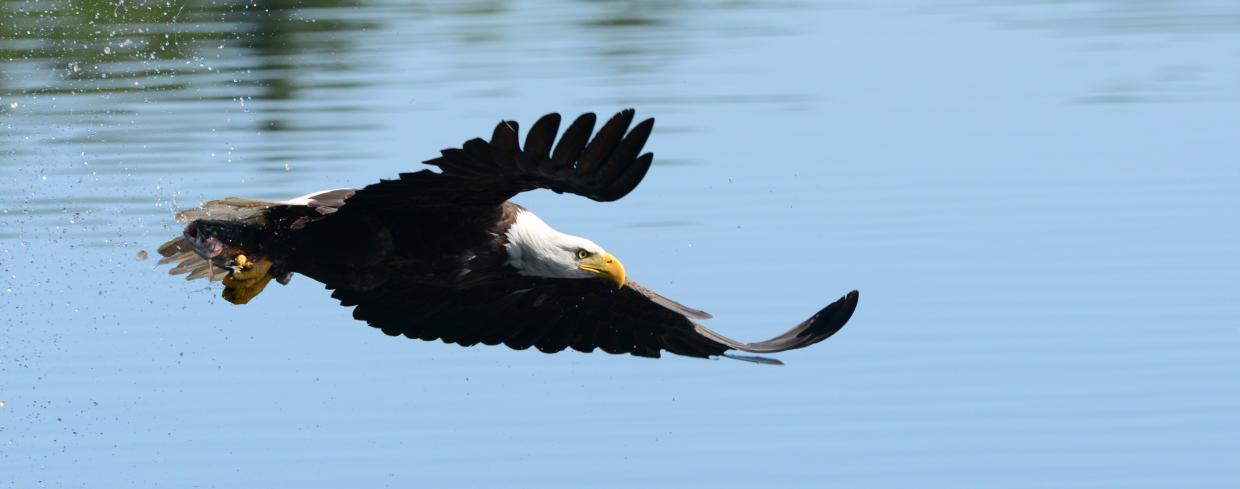Fast facts
Common name: Bald eagle
Scientific name: Haliaeetus leucocephalus
Size: 3 feet in length with a 7-foot wingspan, 8–15 pounds
Range: Alaska and Canada south throughout the United State to Florida and Baja California
Conservation status: Special concern in MA, not listed federally
Fun fact: Largest bird of prey in Massachusetts
Description
Bald eagles are among the most majestic and impressive birds in North America. They are distinctively brown with white heads and tails. The eyes are pale yellow while the beak and feet are bright yellow. Adults attain their plumage at 4–5 years old.
The plumage of juvenile bald eagles varies widely. They are completely dark during the first year, followed by phases with various amounts of white on the underside, backside, underwings, tail, and head. The eyes change from dark brown to the pale yellow of adults. The beak color changes from black-gray to bright yellow when mature.
Similar species: Golden eagles (Aquila chrysaetos) are similar in size. Turkey vultures are also similar in size and can also look like bald eagles, especially from a distance.
Population status
As of 2023, there were more than 80 territorial pairs of bald eagles identified in Massachusetts. Before 2012, bald eagles were listed as endangered in Massachusetts. They are currently listed as special concern in the state. Bald eagles were removed from the Federal Endangered Species List in 2007.
Conservation
Despite being the nation's symbol, bald eagles were targeted and killed for the better part of a century. This intentional killing—coupled with habitat loss and pollutants like DDT—caused breeding bald eagles to disappear from the state in the early 1900s. Beginning in 1982, 41 young eagles from Michigan and Canada were relocated to an area overlooking the Quabbin Reservoir. Due to these efforts, bald eagles began nesting in Massachusetts in 1989. Since then, over 750 bald eagle chicks have fledged in Massachusetts.
MassWildlife has been banding and monitoring bald eagles since 1989. Staff use this information to track bald eagles through an observer network to better learn about these protected birds.
Habitat
Bald eagles usually live in coastal areas, estuaries, and larger inland waters. They require a great amount of shoreline habitat containing stands of forest for nesting and trees projecting above the forest canopy for perching with an unimpeded view. The waterbody they choose typically has a good supply of moderate- to large-sized fish. Wintering eagles are known to use trees over 12 miles from their feeding areas for roosting at night, protected from wind by other trees or land topography.
Life history
Adults can live up to 30 years. However, mortality is relatively high among immature bald eagles.
Bald eagles are sexually mature at 4–6 years old, but they may be considerably older before breeding for the first time. Courtship takes place in mid- to late winter. After courtship, the mated pair builds a large nest in December–February. The nest is built with large sticks and lined with sprigs of pine, grasses, and other soft materials. Male eagles collect the nest materials, delivering them to their mates, which are responsible for most of the actual nest construction.
Once a nesting site is chosen, mated pairs usually return every year and add to the existing nest. Nests are built in hardwood or conifer trees 30–120 feet above the ground. The actual nest may measure 12 feet high and 8.5 feet wide, and weigh hundreds of pounds. Trees selected for nesting—and sometimes for roosting and perching—tend to be relatively large and taller than their surroundings. Ideally, the nest lies below the top of the crown in a live tree, where young are sheltered from the elements and parents can easily take to the sky.
Females lay one to three dull white eggs several days apart usually between early March and early April. Eggs hatch after about 35 days of incubation. Young eaglets grow rapidly and may eat up to two pounds of fish per day. Ten weeks after hatching, they begin to make short flights from the nest. They spend much time with the parent birds, learning how to find and catch food. By late fall, the young eagles leave the nest. Most bald eagles nest within 200 miles of where they are hatched.
Fish—both from freshwater and saltwater—is the main food for bald eagles. They hunt by swooping down from a perch or coursing low over the water, dropping straight down when a fish is spotted.
More information
Learn more about bald eagles with our fact sheet.
Get an overview of the Massachusetts Endangered Species Act.
Additional Resources
-
Open PDF file, 231.76 KB, Graph of Bald Eagle Pairs and Fledglings 1987-2025 (English, PDF 231.76 KB)
Contact
Online
Phone
Open M–F, 8 a.m.–4 p.m. (closed noon–12:30 for lunch)
North/Central/Western Massachusetts
Southeastern Massachusetts/Cape & Islands
